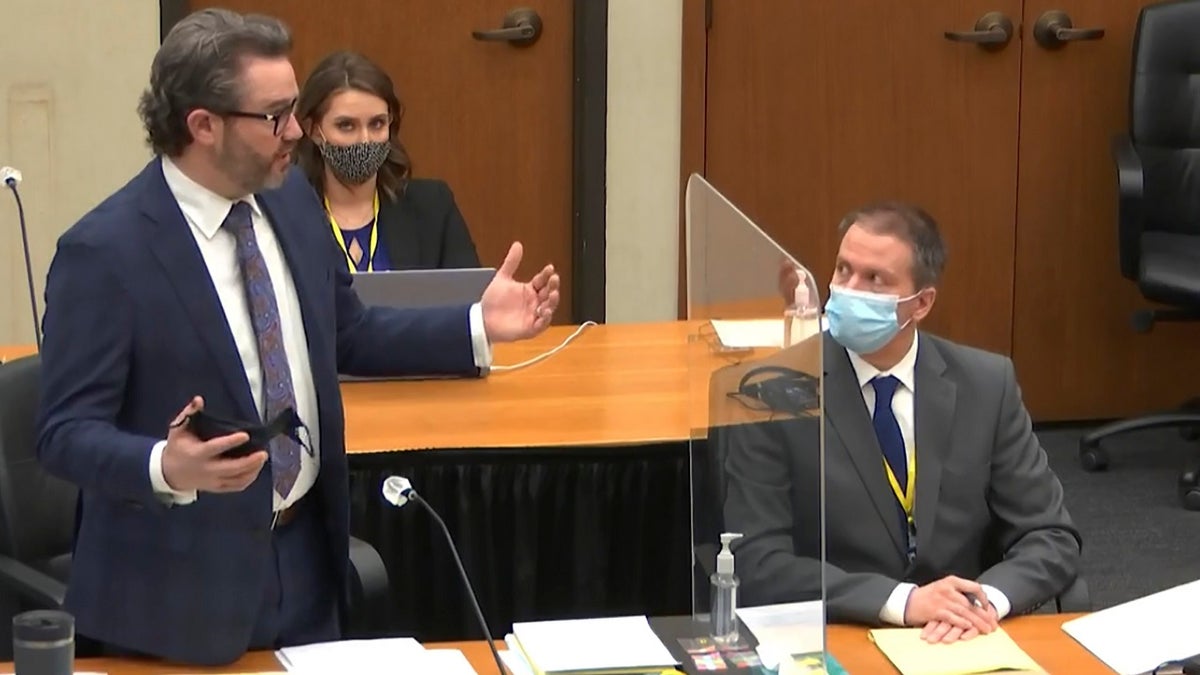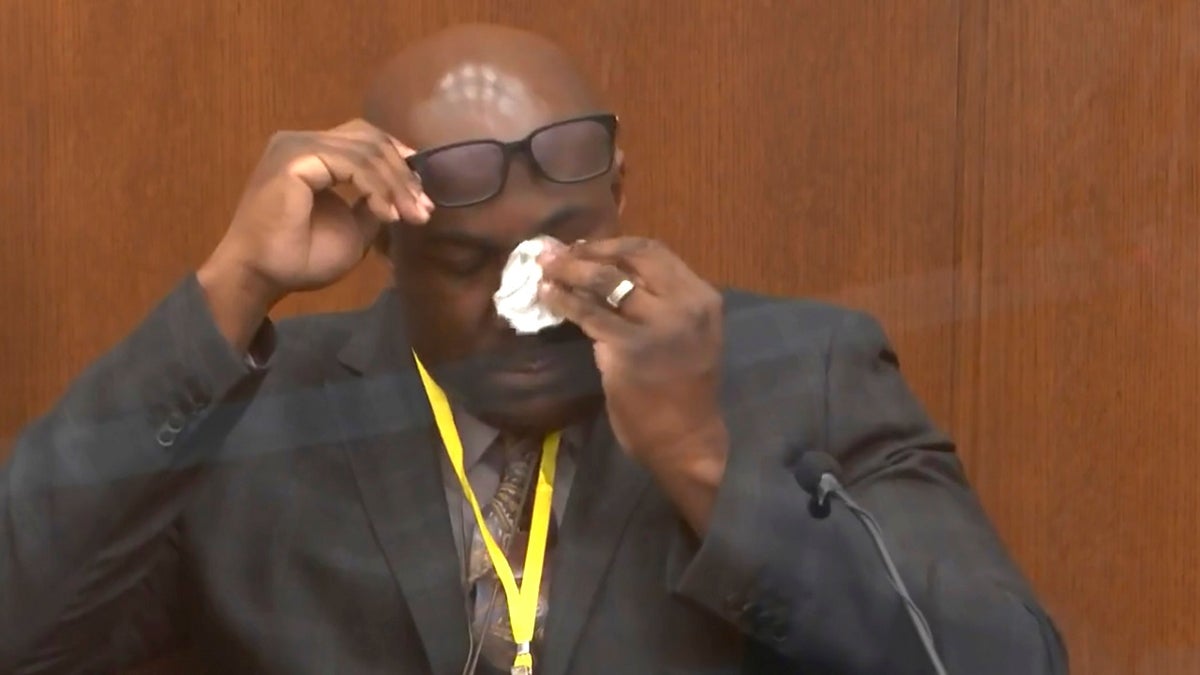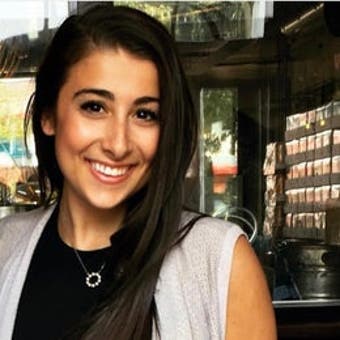Knee on neck of George Floyd 'direct cause' of death: Medical examiner
FOX News legal analyst Mercedes Colwin and defense attorney Richard St. Paul join 'Fox News Live' to discuss the Derek Chauvin trial
The prosecution’s case against former Minneapolis police officer Derek Chauvin drew nearer to a close Monday with George Floyd’s younger brother offering emotional recollections of his late sibling while testimony from a police "use-of-force" expert told the court that no "reasonable" officer would have acted the way Chauvin did.
Chauvin, 45, is on trial for the murder and manslaughter of Floyd, who died during an arrest in Minneapolis on May 25
Seth Stoughton, an associate professor at the University of South Carolina School of Law, judged Chauvin's actions against what a reasonable officer in the same situation would have done, and repeatedly found that Chauvin did not meet that test.
"No reasonable officer would have believed that that was an appropriate, acceptable or reasonable use of force," Stoughton said of the way Floyd was held facedown with a knee across his neck for up to 9 minutes, 29 seconds. "The failure to render aid by taking him out of the prone positon… was unreasonable and contrary to generally accepted practices"
Stoughton also called it unreasonable to think that Floyd might harm officers or escape after he had been handcuffed to the ground. And in yet another blow to the officer's defense, Stoughton said a reasonable officer would not have viewed the bystanders as a threat while they were restraining Floyd.

In this image from video, defense attorney Eric Nelson, left, discusses motions before the court as defendant, former Minneapolis police officer Derek Chauvin, right, and Nelson's assistant Amy Voss, back, listen, Monday, April 12, 2021, as Hennepin County Judge Peter Cahill presides over the trial of Chauvin at the Hennepin County Courthouse in Minneapolis. (Court TV, via AP, Pool)
In the two weeks since the trial began, prosecutors have called nearly 40 people to testify in the case where Floyd, who was 46, died after Chauvin allegedly held his knee against Floyd’s neck for nearly nine-and-a-half minutes despite his shouts that he couldn’t breathe.
Police were responding at the time to a report that Floyd used a counterfeit bill at a nearby convenience store, Cup Food, to buy cigarettes.
LIVE UPDATES: PROSECUTORS IN DEREK CHAUVIN TRIAL MAY REST THEIR CASE WITHIN DAYS
On cross-examination, Chauvin attorney Eric Nelson questioned Stoughton's opinion that putting Floyd on his stomach was itself unreasonable and excessive.
"Reasonable minds can disagree, agreed?" Nelson asked.
Stoughton responded: "On this particular point, no."

In this image from video, Philonise Floyd, brother of George Floyd, becomes emotional as he testifies as Hennepin County Judge Peter Cahill presides over court Monday, April 12, 2021, in the trial of former Minneapolis police Officer Derek Chauvin, in the May 25, 2020, death of George Floyd at the Hennepin County Courthouse in Minneapolis, Minn. (Court TV via AP, Pool)
Earlier in the day, Philonise Floyd took the witness stand and lovingly recalled how his older brother used to make the best banana mayonnaise sandwiches. The sibling also recalled how George drilled him in catching a football, and the way George used to mark his height on the wall as a boy because he wanted to grow taller.
During his testimony, Floyd, 39, began to cry as he was shown a picture of his late mother and a young George, saying, "I miss both of them."
Philonise Floyd described growing up in a poor area of Houston with George and the rest of his family.
"He used to make the best banana mayonnaise sandwiches. And he used to make the best syrup sandwiches because George couldn’t cook, he couldn’t boil water," he said.
He said Floyd also played football and deliberately threw the ball at different angles so Philonise would have to practice diving for it. "I always thought my brother couldn’t throw. But he never intended to throw the ball to me," he said, smiling.
The day's court proceedings began with Dr. Jonathan Rich, a cardiology expert from Northwestern Memorial Hospital in Chicago, echoed previous witnesses in saying Floyd died of low oxygen levels from the way he was held down by police.

In this image from video, Dr. Jonathan Rich, a cardiologist, testifies as Hennepin County Judge Peter Cahill presides over court Monday, April 12, 2021, in the trial of former Minneapolis police Officer Derek Chauvin at the Hennepin County Courthouse in Minneapolis. (Court TV via AP, Pool) ((Court TV via AP, Pool))
He rejected defense theories that Floyd died of a drug overdose or a heart condition. Floyd had fentanyl and methamphetamine in his system, high blood pressure and narrowing of the heart arteries, according to previous testimony.
"It was the truly the prone restraint and positional restraints that led to his asphyxiation," Rich said.
In fact, the expert said, "Every indicator is that Mr. Floyd had actually an exceptionally strong heart."
On cross-examination, Nelson tried to shift blame onto Floyd, asking if Floyd would have survived had he "simply gotten in the back seat of the squad car."
But Rich rejected that line of argument: "Had he not been restrained in the way in which he was, I think he would have survived that day. I think he would have gone home, or wherever he was going to go."
Chauvin's attorney is expected to call his own medical experts to make the case that it was not the officer's knee that killed Floyd. The defense has not said whether Chauvin will testify.

In this image from video, Hennepin County Judge Peter Cahill discusses motions before the court Monday, April 12, 2021, in the trial of former Minneapolis police Officer Derek Chauvin at the Hennepin County Courthouse in Minneapolis. Chauvin is charged in the May 25, 2020 death of George Floyd. (Court TV via AP, Pool)
Before any witness took the stand Monday morning, the judge refused a defense request to immediately sequester the jury. The request came after the killing of a Black man during a traffic stop triggered unrest in a suburb just outside Minneapolis.
Nelson argued that the jurors could be influenced by the prospect of what might happen as a result of their verdict.
DEREK CHAUVIN TRIAL: JUDGE REFUSES TO SEQUESTER JURY IN GEORGE FLOYD MURDER CASE
"Ultimately, your honor, the question becomes: Will the jury be competent to make a decision regardless of the potential outcome of their decision?" he said.
But Judge Peter Cahill said he will not sequester the jury until next Monday, when he anticipates closing arguments will begin. He also denied a defense request to question jurors about what they might have seen about Sunday’s police shooting of 20-year-old Daunte Wright in Brooklyn Center.
Police were trying to arrest Wright on an outstanding warrant on Sunday when an officer apparently mistook her handgun for her Taser and fatally shot him, the police chief said Monday.
Brooklyn Center Police Chief Tim Gannon described the shooting death Sunday of 20-year-old Daunte Wright as "an accidental discharge." It happened as police were trying to arrest Wright on an outstanding warrant. The shooting sparked violent protests in a metropolitan area already on edge because of the trial of the first of four police officers charged in George Floyd’s death.
"I'll Tase you! I'll Tase you! Taser! Taser! Taser!" the officer is heard shouting on her bodycam footage released at a news conference. She draws her weapon after the man breaks free from police outside his car and gets back behind the wheel.
After firing a single shot from her handgun, the car speeds away, and the officer is heard saying, "Holy (expletive)! I shot him."
LIVE UPDATES: DAUNTE WRIGHT POLICE OFFICER SHOOTING BODY-CAMERA FOOTAGE RELEASED
President Joe Biden urged calm on Monday, following a night where officers in riot gear clashed with demonstrators. The president said he watched the body camera footage.
"We do know that the anger, pain and trauma amidst the Black community is real," Biden said from the Oval Office. But, he added, that "does not justify violence and looting."
Gannon said at a news conference that the officer made a mistake, and he released the body camera footage less than 24 hours after the shooting.
The footage showed three officers around a stopped car, which authorities said was pulled over because it had expired registration tags. When another officer attempts to handcuff Wright, a second officer tells Wright he's being arrested on a warrant. That's when the struggle begins, followed by the shooting. Then the car travels several blocks before striking another vehicle.
"As I watch the video and listen to the officer’s command, it is my belief that the officer had the intention to deploy their Taser but instead shot Mr. Wright with a single bullet," Gannon said. "This appears to me from what I viewed and the officer’s reaction in distress immediately after that this was an accidental discharge that resulted in the tragic death of Mr. Wright."
A female passenger sustained non-life-threatening injuries during the crash, authorities said. Katie Wright said that the passenger was her son’s girlfriend.
CLICK HERE TO GET THE FOX NEWS APP
The state Bureau of Criminal Apprehension is investigating.
Minnesota officials, including Gov. Tim Walz have declared a state of emergency and curfew for parts of the state, including Minneapolis and St. Paul.
The Minnesota National Guard is also expected to deploy more than 1,000 personnel in parts of the state ahead of any potential unrest overnight.
Fox News' Danielle Wallace contributed to this report, as well as The Associated Press.





